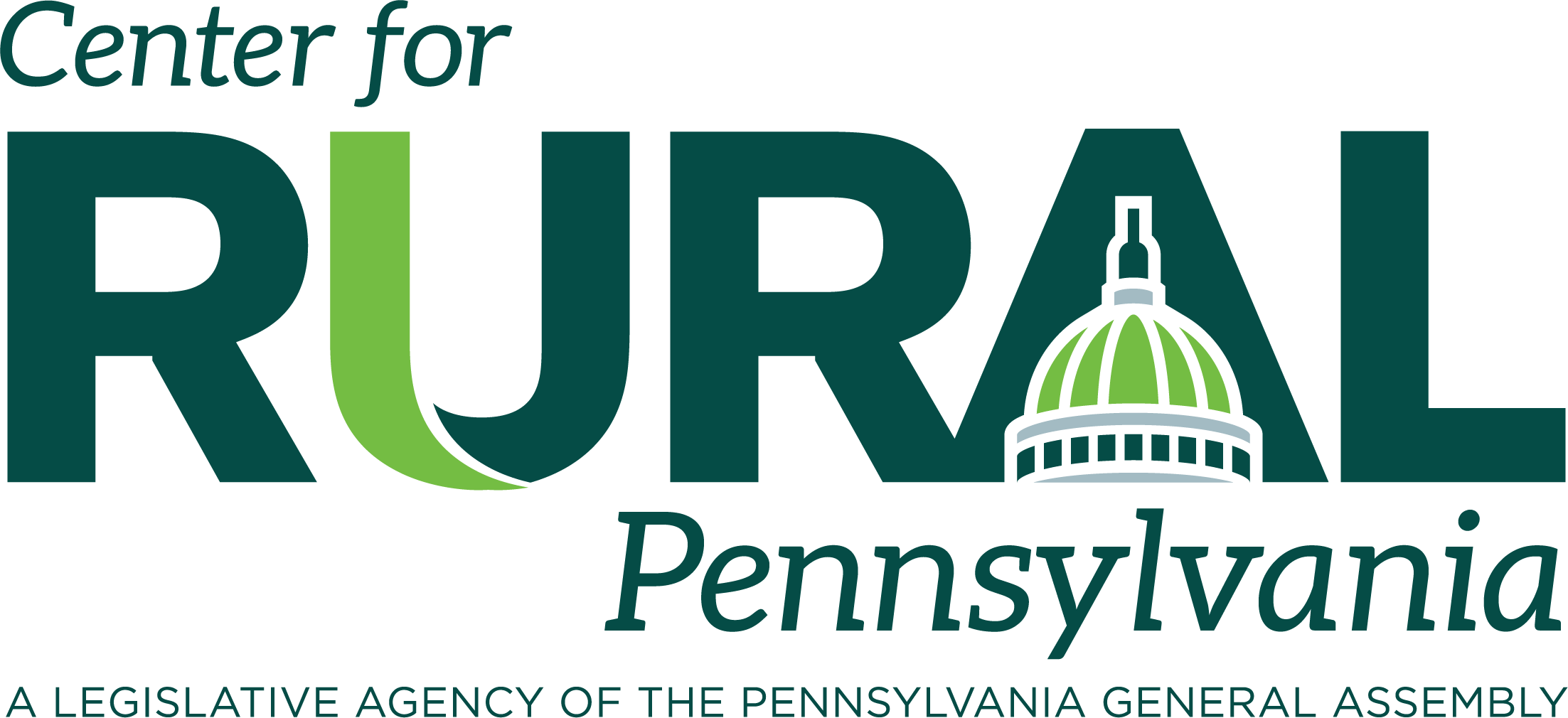Newsletters
- Home
- Publications
- Newsletter Archive
- Newsletter
March/April 2021
Inside This Issue:
- Research Assesses PA Laws, Regulations on Discovery of Historic and Archaeological Human Remains and Burial Sites
- Chairman's Message
- Center Board Elects New Officers, Welcomes New Member
- Rural Snapshot: Public Use Airports and Passengers
- Change in Employees, Employers, 2019 to 2020
- Just the Facts: Cremation
- Law Requires WARN-ing on Business Closures and Layoffs
Research Assesses PA Laws, Regulations on Discovery of Historic and Archaeological Human Remains and Burial Sites
Historic and archaeological human remains and burial sites are found all across Pennsylvania in abandoned or forgotten cemeteries, or in isolated, unmarked areas. The inadvertent discovery of these sites often present unique challenges for development and earth-moving activities. For example, there is little agreement about who has jurisdiction of these sites, who can determine the fate of the remains, and who is financially responsible to ensure that the remains are handled in an appropriate manner.
Through a research grant from the Center for Rural Pennsylvania, Dr. Andrea Palmiotto and Jamie Kouba of Indiana University of Pennsylvania developed a comprehensive assessment of Pennsylvania laws and regulations related to the discovery of historic and archaeological human remains and burial sites. The research included a review of state legislation on human remains, burial grounds, earth moving activities, and historic resources to determine the authority and responsibilities of various public entities involved in mitigation efforts.
The researchers also conducted eight case studies from across Pennsylvania to demonstrate the different procedures that have been employed to navigate the ethical, financial, and administrative challenges associated with these types of situations.
The researchers also developed several policy considerations for Pennsylvania, which are based on legislation established in other states, to address the respectful treatment of remains.
Policy considerations developed from the research include the following:
- Enact legislation specifically for archaeological and historic human remains and burials that allows for respectful treatment of remains and supervision of procedures by professional archaeologists. The research suggests that this legislation supersede all other legislation that has been and may be applied to these types of cases.
- Upon discovery of possible human remains or burials, all work should stop immediately. Law enforcement should be notified within 48 hours and failure to comply should result in appropriate penalties. When remains are encountered during archaeological excavation, and/or when remains are determined to be more than 100 years old (not of medicolegal significance), law enforcement should notify the State Historic Preservation Office (SHPO) immediately. Legislation should distinguish between procedures for cemeteries and isolated burials.
- SHPO should have an appropriate annual budget to ensure it can fulfill its role, including: reviewing state-issued permits for construction and water quality; providing written documentation about site significance and allotted days for notification and survey; analyzing skeletal remains; notifying descendants; and establishing appropriate contingency plans.
- Financial responsibilities for disinterment and relocation should be the burden of the developer unless a descendant or cultural group claims responsibility for the remains.
- Archaeological monitors and osteology professionals should meet the U.S. Secretary of the Interior’s criteria for professional archaeologists. Additionally, SHPO should maintain a searchable list of firms and/or professionals, including osteologists and monument conservationists, who can be contacted to assist with projects.
The report, Assessment of Legislation Applied to Historic and Archaeological Human Remains and Burial Sites in Pennsylvania, is available here.
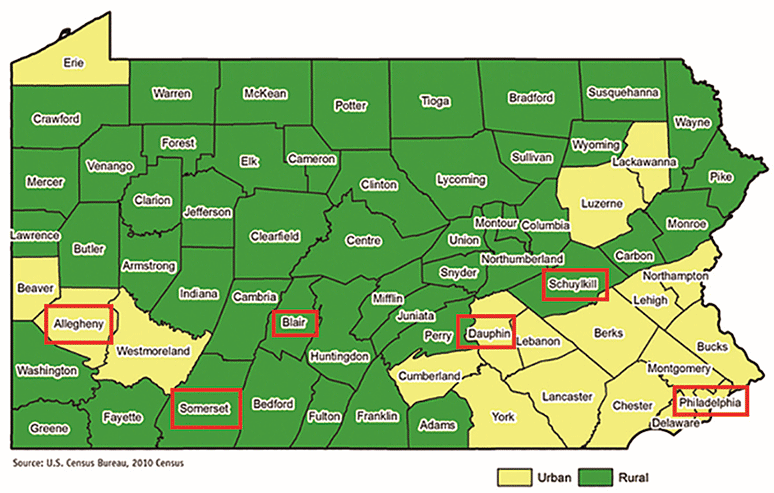
The research conducted eight case studies in six Pennsylvania counties (outlined in red). The case studies provided insight into the different ways that archaeological and historic human remains have been handled when encountered during development projects in Pennsylvania.
Chairman's Message
In January and February, the Center held four public hearings on a range of important issues, including the COVID-19 vaccine rollout in rural Pennsylvania, shrinking commercial air service at rural airports, the impact of the COVID pandemic on the heroin/opioid crisis, and expanding broadband access in rural Pennsylvania.
In three of the four public hearings, broadband was an important part of the conversation. Time and time again, the hearing participants noted how vital broadband is to our economy, our healthcare system, our schools, and more.
The public hearing on expanding broadband in rural areas featured Tri-County Rural Electric Cooperative (REC) and its subsidiary Tri-Co Connections, and the work they have been doing to deploy fiber optic broadband in the north central region of Pennsylvania.
Tri-County REC answered the call from its membership to deploy broadband in a region where high-speed service was unreliable or unavailable. It knew the challenges of the region’s geography and low-population density, but it also recognized the similarities between the need for rural electrification at the beginning of the 20th Century and the need for rural broadband today.
With the help of state and federal grants and loans, and by working with the Pennsylvania Public Utility Commission to address regulatory barriers, Tri-Co Connections began installing fiber optic cable in early 2020, and has now installed some 500 miles of fiber to connect 700 commercial and residential members. Additional featured hearing participants, who represented Develop Tioga, an economic development agency, Potter County Education Council, and Oswayo Valley School District, all noted their work with Tri-Co Connections in supporting broadband expansion for the benefit of employers and employees, entrepreneurs, ag producers, teachers, students, and senior citizens.
Through this hearing, we wanted to share a great example of how one organization worked with its membership and regional stakeholders to make broadband available to a region where the persistent lack of broadband hampered economic and community development, health care outreach, and educational opportunities. We hope it inspires others who may want to follow suit.
Thank you to everyone who participated in all the Center’s hearings, and to everyone who attended.
If you didn’t have the opportunity to attend the broadband hearing, or any of the other public hearings, click here for links to the video recording of each hearing.
Senator Gene Yaw
Center Board Elects New Officers, Welcomes New Member

Sen. Yaw

Rep. Pashinski

Dr. Falvo

Mr. Brame
At its February meeting, the Center for Rural Pennsylvania Board of Directors elected officers for the 2021-2022 legislative session.
The board reelected Senator Gene Yaw chairman, Dr. Nancy Falvo secretary, and Steve Brame treasurer. The board elected Representative Eddie Day Pashinski vice chairman.

Rep. Moul
The board also welcomed Representative Dan Moul. Rep. Moul serves the 91st Legislative District, which includes Conewago, Cumberland, Franklin, Freedom, Germany, Hamiltonban, Highland, Liberty, Mount Joy, Mount Pleasant, Straban, and Union townships, and Bonneauville, Carroll Valley, Fairview, Gettysburg, Littlestown, and McSherrystown boroughs in Adams County.
He was first elected to the House of Representatives in 2006. Currently, he serves as chairman of the Agriculture and Rural Affairs Committee, and as a member of the Tourism and Recreational Development Committee.
Rural Snapshot: Public Use Airports and Passengers
Pennsylvania Commercial Service Airport Passengers (Enplanements), 2019
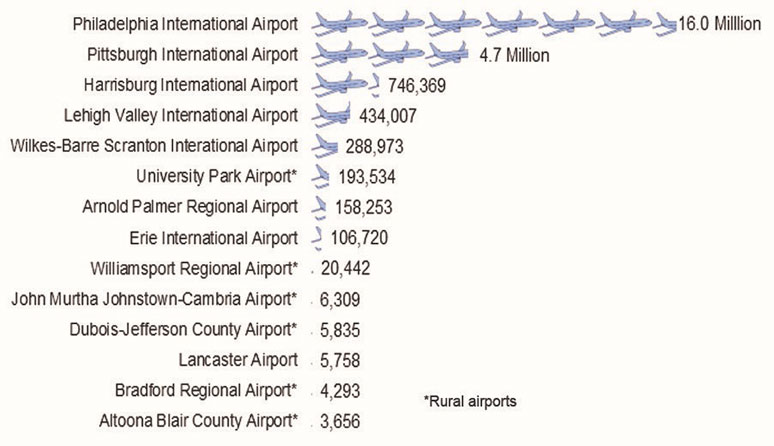
Data source: Federal Aviation Administration.
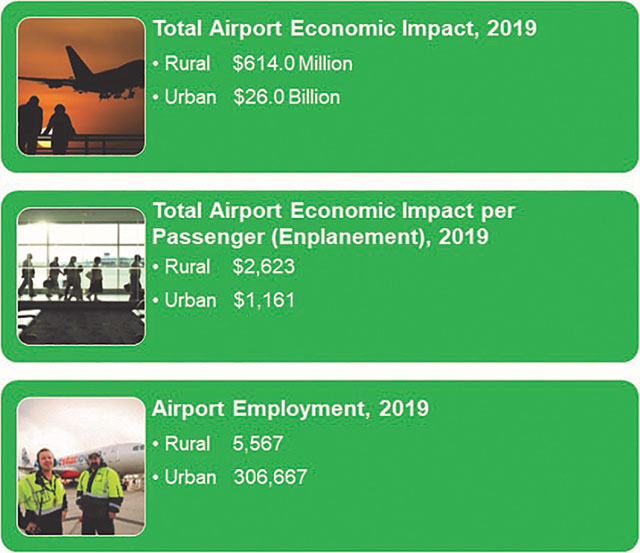
Data source: Pennsylvania Department of Transportation.
Public Use Airports in Pennsylvania, 2020
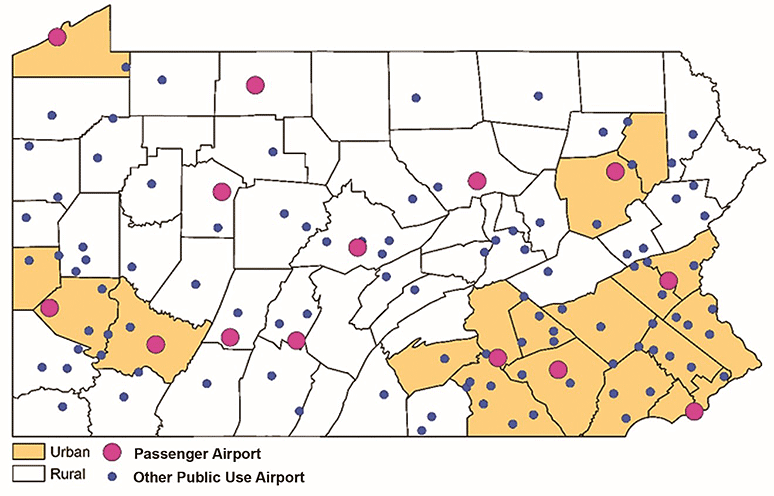
Note: Includes only airports with reported passengers (enplanements) in 2019. Data source: Federal Aviation Administration.

43% Percent of rural Pennsylvania population living within 25 miles of a passenger airport.
86% Percent of urban Pennsylvania population living within 25 miles of a passenger airport.
Data source: Federal Aviation Administration, and U.S. Census Bureau.
Number of Fixed Wing Aircraft by Ownership in Rural and Urban Pennsylvania, 2020
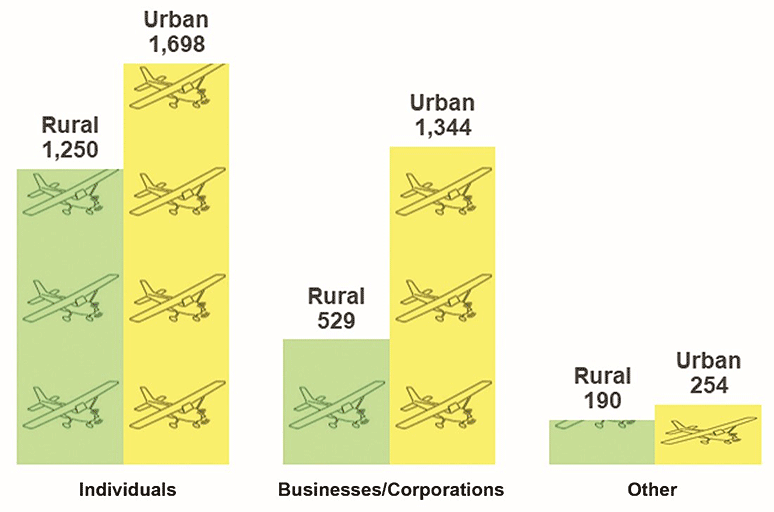
Data source: Federal Aviation Administration.
Number of Rural Airplane Pilots by Type, 2020
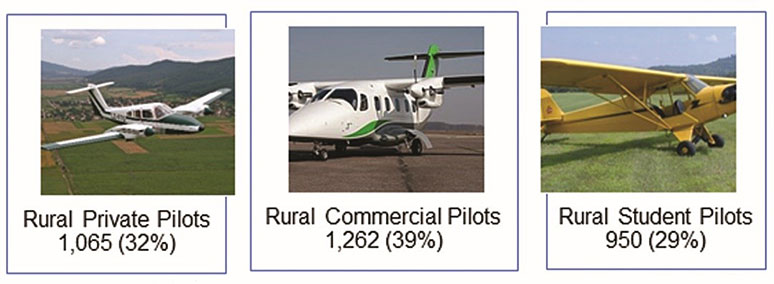
Data source: Federal Aviation Administration.
On February 4, the Center’s Board of Directors sponsored a public hearing to examine rural aviation and the decision by American Airlines to drop flights from many smaller U.S. cities, including Williamsport. More information on the hearing is available here.
Change in Employees, Employers, 2019 to 2020
Percent Change in the Number of Private Sector Employees, by County, 3rd Quarter 2019 to 3rd Quarter 2020
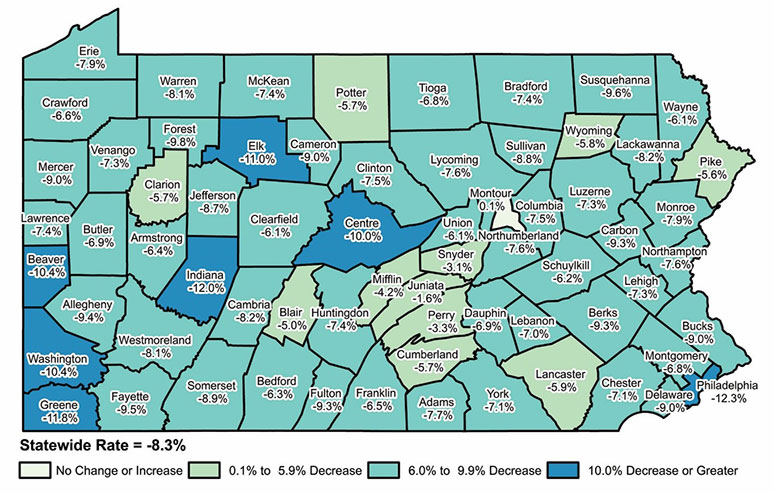
Percent Change in the Number of Private Sector Employers, with Paid Employees, by County, 3rd Quarter 2019 to 3rd Quarter 2020
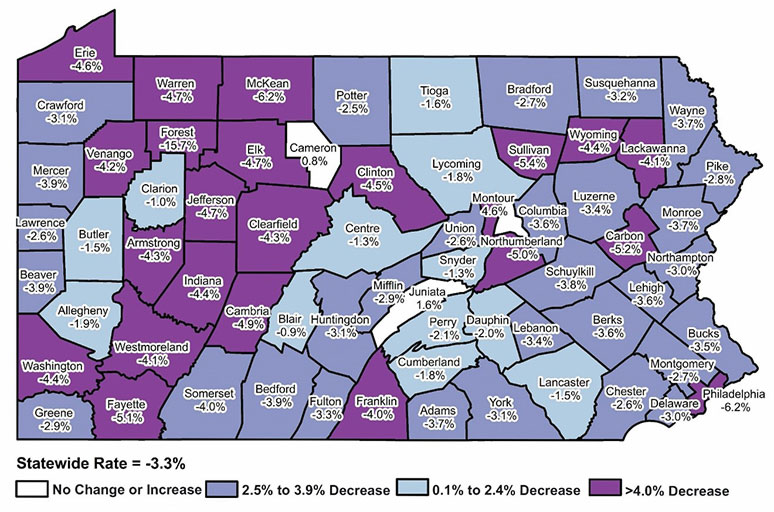
Data source: Pennsylvania Department of Labor and Industry.
Just the Facts: Cremation
There has been an evolving shift toward cremation over the past three decades, according to data from the Pennsylvania Department of Health.
In 1990, 89 percent of deceased rural residents were buried, 9 percent were cremated, and the final disposition of the remaining 2 percent was by other means (taken out of state or donated). Nearly 30 years later, in 2019, these figures are reversed: 43 percent were buried, 53 percent were cremated, and the final disposition of the remaining 4 percent were by other means.
In urban counties, there was a similar pattern. In 1990, 86 percent of urban decedents were buried, 12 percent were cremated, and the disposition of 2 percent were by other means. In 2019, 42 percent were buried, 53 percent were cremated, and 5 percent were by other means.
In Pennsylvania, the three counties with the highest cremation rates in 2019 were Tioga, Pike, and Cameron, each with a rate greater than 67 percent. The three counties with the lowest cremation rates were Fulton, Bedford, and Juniata, each with a rate lower than 41 percent.
The increase in Pennsylvania cremation rates is not unique. Data from the trade association, Cremation Association of North America, indicated that, in 2018, 53 percent of decedents in the United States were cremated.
Data from the National Funeral Directors Association (NFDA) indicated that this trend will continue. NFDA projects that by 2040, 78 percent of decedents will be cremated.
One possible reason for the shift is cost. In 2019, NFDA estimated that the median cost of burial with a viewing was $9,135, while cremation with a viewing was $5,150.
Pennsylvania Cremation Rates, 1990 to 2019
(Cremation as Percent of Total Dispositions)
Data source: Pennsylvania Department of Health.
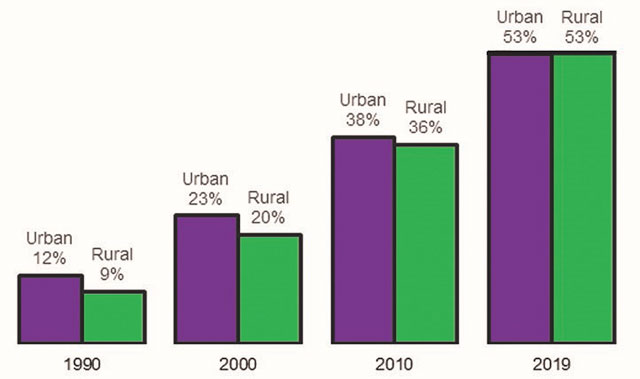
Law Requires WARN-ing on Business Closures and Layoffs
The onset of COVID-19 has affected businesses large and small across the nation and in Pennsylvania. One way to examine the pandemic’s impact on businesses is to look at data from the Workers Adjustment and Retraining Notification Act (WARN).
WARN, enacted in 1988, is a U.S. labor law that helps protect employees, their families, and communities by requiring most employers with 100 or more employees to provide 60-calendar-days advance notice of plant closings and mass layoffs affecting 50 or more employees at a single site of employment.
In Pennsylvania, in 2020, 430 WARN notices were issued, 52 of which were from businesses in rural counties, 370 from businesses in urban counties, and the remaining from businesses that were located in multiple counties. These WARN notices affected 58,080 urban workers, and 6,248 rural workers. In total, these notices affected about 1 percent of the entire Pennsylvania workforce.
Statewide, each WARN notice affected 160 workers, on average. Of the 71 percent of businesses that provided information on whether the notice was temporary and/or COVID-19 related, 75 percent said their actions were due to COVID-19 (51 percent of businesses in rural counties, and 78 percent of businesses in urban counties). Among the businesses that responded to the question, 54 percent in rural counties and 34 percent in urban counties said these changes were permanent.
For more information on WARN, click here.
